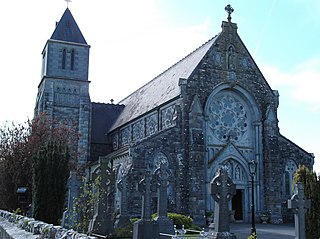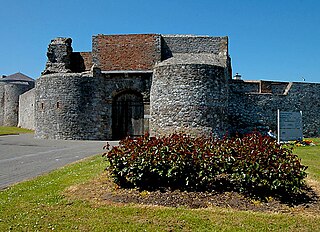
Thomas Cantock, Quantock or Cantok was an English-born cleric and judge in medieval Ireland, who held the offices of Bishop of Emly and Lord Chancellor of Ireland.
Walter de Thornbury was an English-born statesman and cleric who held the office of Lord Chancellor of Ireland in the 14th century. His efforts to secure confirmation of his election as Archbishop of Dublin ended in tragedy with his death in a shipwreck.
Richard de Beresford or Bereford was an English-born cleric and judge who held high political office in Ireland in the early fourteenth century as Lord High Treasurer of Ireland and Lord Chancellor of Ireland.

Sir John Wogan or John de Wogan, styled lord of Picton was a Cambro-Norman judge who served as Justiciar of Ireland from 1295 to 1313. There are several dubious theories about Wogan's ancestry, and uncertainty exists about his wives, sons, and other relations. He came from Picton in Pembrokeshire and was a vassal of William de Valence, 1st Earl of Pembroke. He came to have lands in Pembrokeshire, Somerset, Dorset, Devon, Wiltshire, and Oxfordshire. He may have represented de Valence at an Irish court case in 1275, and in 1280 he was steward of Wexford, Valence's Irish liberty. He was a justice in eyre in England in 1281–4, and returned to Ireland in 1285. In 1290 he was a referee with Hugh Cressingham in a dispute between Queen Eleanor and de Valence and his wife. He was on eyre again in the mid-1290s, sitting in the North of England.
Sir Robert Bagod was an Irish judge who was appointed the first Chief Justice of the Irish Common Pleas in 1276. He built Baggotrath Castle, which was the strongest fortress in Dublin: it was located on present-day Baggot Street in central Dublin. He also founded the Carmelite Friary in Dublin.
Nicholas de Balscote was an English-born official and judge in fourteenth-century Ireland. He attained high judicial office, but his career was damaged by a quarrel with King Edward II.
John Keppock was an Irish judge of the late fourteenth century, who held the offices of Lord Chief Justice of Ireland, Chief Baron of the Irish Exchequer and Deputy Lord Chancellor of Ireland. He became a politician of some importance.
Nicholas Lumbard or Lombard was an Irish barrister and judge of the fourteenth century.
John de Ponz, also called John de Ponte, John Savan, or John of Bridgwater (c.1248–1307) was an English-born administrator, lawyer and judge in the reign of King Edward I. He served in the Royal Household in England for several years before moving to Ireland, where he practised in the Royal Courts as the King's Serjeant-at-law (Ireland). He later served as a justice in eyre, and then as a justice of the Court of Common Pleas (Ireland). He was a gifted lawyer, but as a judge was accused of acting unjustly. A case he heard in Kilkenny in 1302 can be seen as a precursor of the Kilkenny Witchcraft Trials of 1324, and involved several of the main actors in the Trials.
Sir William le Deveneys was a Crown administrator and judge in late thirteenth and early fourteenth century Ireland, who served very briefly as Chief Justice of the Irish Common Pleas.
Walter de Cusack was an Anglo-Irish judge, magnate and military commander of the fourteenth century.
Hugh Canoun, or Hugh Canon was an English-born judge in early fourteenth-century Ireland. He was a justice of the Court of Common Pleas (Ireland) and served as Deputy Justiciar of Ireland. As a judge he was praised for his good and faithful service to the English Crown, and as a lawyer he was known as "a man very knowledgeable about all the King's business". On the other hand, his loyalty to the Crown during the Scottish Invasion of Ireland in 1315-18 was said to be extremely doubtful, although he was saved from disgrace by his influential connections. He was murdered by Andrew de Bermingham of Athenry in 1317/18, during the last months of the Bruce Invasion, in the course of a private feud, of which little is known.

Henry de Thrapston, or Henry Trapeston was an English cleric, judge and Crown official who spent most of his career in Ireland, where he became Chancellor of the Exchequer of Ireland and Archdeacon of Cork.
Walter FitzWilliam Cotterell was an Irish barrister and Crown official of the late fourteenth century. He was Serjeant-at-law (Ireland) and acted from time to time as a judge of gaol delivery and of assize, although he was never a justice in the Royal Courts. The evidence suggests that he was a conscientious and hard-working official who enjoyed the complete trust of the English Crown.

Sir Walter de la Haye, or de Haye was an English-born statesman and judge in Ireland of the late thirteenth and early fourteenth centuries, who served for many years as Sheriff of County Waterford and as Chief Escheator of Ireland, and briefly as Justiciar of Ireland.
Simon de Ludgate was an English-born judge in Ireland in the reign of King Edward I of England, who held office as Chief Justice of the Common Pleas for Ireland.
David le Blond was an Irish judge in the reign of King Edward II of England, who was notorious for corruption.

Sir William de Essendon, de Estdene or Eastdean was an English-born cleric, lawyer and Crown official, much of whose career was spent in Ireland in the reign of Edward I of England and his son. He served twice as Lord High Treasurer of Ireland, and had a high reputation for integrity and efficiency.
William fitz Roger was an Anglo-Norman cleric, judge and Crown official in late thirteenth-century Lordship of Ireland. He was Prior of the Irish House of the Knights Hospitallers at Kilmainham, and served as a Privy Councillor and as a justice in eyre. He led several military expeditions, but was a notoriously incompetent commander, whose campaigns invariably ended in failure. He served as Deputy Justiciar in 1284-5, and as acting Justiciar of Ireland in 1294.
Sir Richard Duket was an English Crown official who had a highly successful career in England and Ireland, and enjoyed the confidence of two English monarchs, John and Henry III. In a career spanning more than forty years, he served variously as a judge, diplomat, King's Messenger, Sheriff and Royal Secretary.